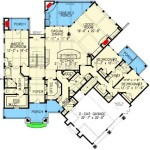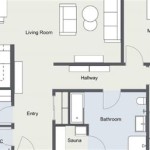Remodel house plans are comprehensive blueprints that outline the structural changes, material upgrades, and design elements involved in a home renovation project. These plans serve as a roadmap for contractors and homeowners, ensuring that all aspects of the remodel are carefully planned and executed. For instance, a remodel house plan might encompass the complete overhaul of a kitchen, including the layout, cabinetry, appliances, and flooring.
Creating remodel house plans is a crucial step in any home renovation endeavor. They establish the scope of the project, define the timeline, and prevent costly mistakes during construction. By collaborating with architects, designers, and contractors, homeowners can develop detailed plans that align with their vision, budget, and building codes. In addition, remodel house plans facilitate communication among all parties involved in the project, ensuring that everyone is on the same page throughout the renovation process.
In the following sections, we will explore the components of remodel house plans, discuss the benefits of proper planning, and provide guidance on creating a comprehensive plan for your next home renovation project.
Remodel House Plans present numerous advantages that can enhance your home renovation project. Here are 9 important points to consider:
- Comprehensive Planning
- Defined Scope
- Cost Control
- Error Prevention
- Improved Communication
- Increased Efficiency
- Enhanced Safety
- Permit Compliance
- Future Proofing
By incorporating these elements into your remodel house plans, you can ensure a successful and satisfying renovation experience.
Comprehensive Planning
Remodel house plans provide a comprehensive roadmap for your renovation project, ensuring that every aspect is carefully considered and executed. Comprehensive planning involves:
- Establishing a clear vision and scope for the project: Define the goals of the remodel, including the desired changes to the layout, functionality, and aesthetics of the home.
- Conducting a thorough assessment of the existing structure: Evaluate the condition of the home’s foundation, walls, roof, and systems. This assessment helps identify potential issues that need to be addressed during the remodel.
- Developing detailed drawings and specifications: Create blueprints that outline the proposed changes to the home’s structure, electrical system, plumbing, and HVAC system. These drawings should also include material specifications, such as the types of flooring, cabinetry, and fixtures to be used.
- Obtaining necessary permits and approvals: Secure building permits from the local building department and approvals from any homeowners associations or historical preservation boards that may have jurisdiction over the property.
By engaging in comprehensive planning, homeowners can avoid costly mistakes, ensure that their project meets building codes and regulations, and create a home that meets their specific needs and preferences.
Defined Scope
A well-defined scope is crucial for a successful remodel house plan. It outlines the specific changes to be made to the home, ensuring that all parties involved have a clear understanding of the project’s goals and limitations.
Defining the scope of a remodel involves identifying the following:
- Specific areas of the home to be remodeled: This could include the kitchen, bathrooms, living room, or entire house.
- Changes to the layout: Are walls being moved, rooms being added or removed, or the flow of the home being altered in any way?
- Upgrades to finishes and materials: This includes flooring, cabinetry, countertops, appliances, fixtures, and paint colors.
- Modifications to systems: Are there any changes planned to the electrical, plumbing, or HVAC systems?
- Timeline and budget: Establishing a realistic timeframe and budget for the project helps ensure that it is completed on schedule and within financial constraints.
Once the scope of the remodel has been defined, it should be documented in writing and shared with all parties involved, including the homeowner, architect, contractor, and subcontractors. A well-defined scope helps prevent misunderstandings, change orders, and delays during the construction process.
In addition to providing clarity and direction, a defined scope also helps control costs and avoid unnecessary expenses. By carefully planning the changes to be made and identifying the specific materials and finishes to be used, homeowners can make informed decisions and allocate their budget wisely.
Cost Control
Remodel house plans play a critical role in cost control by providing a clear and detailed roadmap for the project. By carefully planning the scope of work and specifying the materials and finishes to be used, homeowners can make informed decisions and avoid unnecessary expenses.
- Accurate Cost Estimates: Detailed remodel house plans allow contractors to provide more accurate cost estimates. With a clear understanding of the project’s scope and requirements, contractors can identify and price all necessary materials, labor, and permits. This helps homeowners avoid unexpected costs and budget overruns during construction.
- Value Engineering: Remodel house plans facilitate value engineering, a process of analyzing and optimizing the design to reduce costs while maintaining functionality and aesthetics. By considering alternative materials, finishes, and construction methods, homeowners can identify areas where they can save money without sacrificing quality.
- Material Selection: Remodel house plans help homeowners make informed decisions about the materials and finishes to be used in their remodel. By comparing the costs and benefits of different options, homeowners can select materials that fit within their budget and meet their performance and aesthetic requirements.
- Change Order Minimization: Comprehensive remodel house plans minimize the need for change orders during construction. By clearly defining the scope of work upfront, homeowners can reduce the likelihood of unexpected changes that can lead to additional costs and delays.
Overall, remodel house plans are essential for cost control in home renovation projects. By providing a clear roadmap for the project and facilitating informed decision-making, homeowners can avoid costly mistakes and ensure that their remodel stays within budget.
Error Prevention
Remodel house plans play a crucial role in error prevention by providing a detailed and comprehensive guide for the construction process. By carefully planning the project and specifying the materials and methods to be used, homeowners can minimize the risk of errors that can lead to costly delays and rework.
One of the key ways that remodel house plans prevent errors is by ensuring that all aspects of the project are thoroughly considered and coordinated. A well-designed plan will take into account the structural integrity of the home, the functionality of the new layout, and the compatibility of different materials and systems. This comprehensive approach helps to identify potential problems early on, before they can cause costly delays or safety hazards.
Another important aspect of error prevention is the use of detailed drawings and specifications in remodel house plans. These documents provide clear instructions for the contractors and subcontractors working on the project, reducing the likelihood of misinterpretations or mistakes. By specifying the exact materials, dimensions, and construction methods to be used, remodel house plans help to ensure that the project is executed according to the homeowner’s vision and expectations.Furthermore, remodel house plans facilitate effective communication among all parties involved in the project, including the homeowner, architect, contractor, and subcontractors. By providing a shared reference point, the plans help to prevent misunderstandings and ensure that everyone is working towards the same goals. This open communication helps to identify and resolve potential issues early on, before they can escalate into major problems.In addition to the benefits mentioned above, remodel house plans also contribute to error prevention by providing a basis for quality control and inspection. The detailed drawings and specifications in the plans allow for regular inspections to ensure that the work is being completed according to the approved design. This helps to identify any deviations from the plan and address them promptly, preventing errors from becoming greren issues.
Overall, remodel house plans are essential for error prevention in home renovation projects. By providing a clear roadmap for the project, facilitating effective communication, and establishing a basis for quality control, remodel house plans help to minimize the risk of costly mistakes and ensure that the project is completed successfully.
Improved Communication
Remodel house plans serve as a central hub for communication among all parties involved in a home renovation project, including the homeowner, architect, contractor, and subcontractors. By providing a shared reference point, the plans help to ensure that everyone has a clear understanding of the project’s goals, scope, and requirements.
One of the key benefits of remodel house plans in improving communication is that they provide a common language for all parties involved. The detailed drawings and specifications in the plans allow everyone to visualize the project and understand the intended outcome. This shared understanding helps to prevent misunderstandings, misinterpretations, and costly mistakes.
Furthermore, remodel house plans facilitate effective communication throughout the construction process. The plans provide a platform for discussions, decision-making, and problem-solving. By referring to the plans, the homeowner, architect, contractor, and subcontractors can identify potential issues early on and work together to find solutions that meet the project’s goals and constraints.
In addition, remodel house plans help to streamline communication by providing a central repository for all project-related information. The plans can be used to track changes, document decisions, and share updates with all parties involved. This centralized approach ensures that everyone has access to the most up-to-date information and can stay informed about the project’s progress.
Overall, remodel house plans play a crucial role in improving communication among all parties involved in a home renovation project. By providing a shared reference point, a common language, and a platform for ongoing communication, remodel house plans help to ensure that everyone is working towards the same goals and that the project is completed successfully.
Increased Efficiency
Remodel house plans contribute to increased efficiency in home renovation projects by providing a clear roadmap for the construction process. By carefully planning the project and specifying the materials and methods to be used, homeowners can streamline the construction process and minimize delays.
- Optimized Construction Sequence: Remodel house plans establish a logical sequence for the construction process, ensuring that tasks are completed in the most efficient order. This helps to avoid delays and minimize disruptions during construction.
- Improved Material Management: Detailed remodel house plans allow for accurate material ordering and delivery schedules. By knowing the exact quantities and specifications of materials needed, homeowners can avoid costly delays due to material shortages or surpluses.
- Reduced Labor Costs: Well-coordinated remodel house plans help to reduce labor costs by minimizing the need for rework and troubleshooting. Clear instructions and detailed drawings ensure that contractors can work efficiently and avoid costly mistakes.
- Faster Project Completion: By streamlining the construction process and improving efficiency, remodel house plans can help to reduce the overall project completion time. This can save homeowners money on labor costs and allow them to enjoy their remodeled home sooner.
Overall, remodel house plans play a crucial role in increasing efficiency in home renovation projects. By providing a clear roadmap for the construction process and optimizing the use of materials and labor, remodel house plans help to minimize delays, reduce costs, and ensure that the project is completed on time and within budget.
Enhanced Safety
Remodel house plans play a critical role in enhancing safety during home renovation projects. By carefully considering safety regulations, structural integrity, and material selection, remodel house plans help to create a safe and healthy living environment for homeowners and their families.
- Compliance with Building Codes: Remodel house plans ensure compliance with local building codes and safety regulations. These codes are designed to protect the health, safety, and welfare of occupants by regulating structural integrity, fire safety, electrical systems, and other aspects of home construction. By adhering to building codes, remodel house plans help to prevent accidents and ensure the safety of the home.
- Structural Integrity: Remodel house plans carefully consider the structural integrity of the home, especially when making changes to the load-bearing walls, roof, or foundation. Structural engineers review the plans to ensure that the proposed changes will not compromise the safety of the home. Proper structural design helps to prevent collapses, failures, and other safety hazards.
- Electrical and Plumbing Safety: Remodel house plans include detailed electrical and plumbing plans that comply with safety standards. These plans ensure that electrical wiring and plumbing systems are installed correctly, minimizing the risk of electrical shocks, fires, water leaks, and other hazards. Proper electrical and plumbing design helps to create a safe and comfortable living environment.
- Material Selection: Remodel house plans specify the materials to be used in the renovation, taking into account their safety characteristics. For example, fire-resistant materials may be specified for areas around fireplaces or stoves, and non-slip flooring may be used in bathrooms and kitchens to prevent falls.
Overall, remodel house plans play a crucial role in enhancing safety in home renovation projects. By ensuring compliance with building codes, considering structural integrity, addressing electrical and plumbing safety, and selecting safe materials, remodel house plans help to create a secure and healthy living environment for homeowners and their families.
Permit Compliance
Remodel house plans play a critical role in ensuring permit compliance for home renovation projects. Building permits are required for most major renovations, as they ensure that the work is completed safely and in accordance with local building codes and regulations. Remodel house plans provide the necessary documentation to obtain the required permits and demonstrate compliance with the applicable codes.
- Compliance with Local Regulations: Remodel house plans must comply with local building codes and zoning ordinances. These regulations govern various aspects of home construction, including structural integrity, fire safety, energy efficiency, and accessibility. By adhering to these regulations, remodel house plans help to ensure that the renovation project meets the minimum safety and quality standards required by law.
- Detailed Documentation: Remodel house plans provide detailed documentation of the proposed changes to the home, including structural modifications, electrical and plumbing upgrades, and material specifications. This documentation is essential for obtaining building permits, as it allows the building department to review the plans and assess whether the project complies with the applicable codes.
- Professional Review: In many cases, remodel house plans must be reviewed and approved by licensed architects or engineers. These professionals ensure that the plans meet the technical requirements of the building codes and that the proposed changes are structurally sound and safe. Their approval adds credibility to the plans and increases the likelihood of obtaining the necessary permits.
- Inspection Process: Once the building permit is issued, the local building department will conduct inspections throughout the construction process to ensure that the work is completed according to the approved plans. Remodel house plans serve as a reference for the inspectors, allowing them to verify that the project is compliant with the permitted design.
Overall, remodel house plans are essential for permit compliance in home renovation projects. By providing detailed documentation, ensuring compliance with local regulations, and facilitating professional review and inspections, remodel house plans help homeowners navigate the permitting process smoothly and ensure that their project is completed safely and legally.
Future Proofing
Remodel house plans play a critical role in future proofing homes, ensuring that they remain functional, comfortable, and sustainable for years to come. Future proofing involves anticipating and incorporating design elements and technologies that will meet the evolving needs of homeowners and the changing demands of modern living.
Adaptable Design: Remodel house plans can incorporate adaptable design features that allow the home to be easily modified or reconfigured in the future. This may include flexible room layouts, movable walls, and universal design elements that enhance accessibility and functionality for people of all ages and abilities. By designing for adaptability, homeowners can create a home that can evolve with their changing lifestyle and needs.
Technology Integration: Remodel house plans can integrate smart home technologies that enhance convenience, comfort, and energy efficiency. This may include smart lighting, automated climate control, home security systems, and smart appliances. By incorporating these technologies, homeowners can future proof their homes and enjoy the benefits of a connected and automated living environment.
Sustainable Materials and Practices: Remodel house plans can prioritize sustainable materials and construction practices to reduce the environmental impact of the home. This may include using energy-efficient appliances and lighting, installing solar panels, and incorporating recycled or renewable materials. By designing for sustainability, homeowners can create a home that is not only comfortable and stylish but also environmentally responsible.
Overall, remodel house plans that embrace future proofing principles create homes that are adaptable, technologically advanced, and sustainable. By anticipating and incorporating design elements and technologies that meet the evolving needs of modern living, homeowners can enjoy a home that will continue to meet their needs and enhance their quality of life for years to come.










Related Posts








